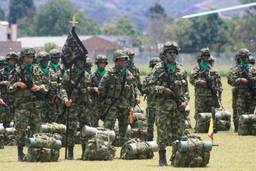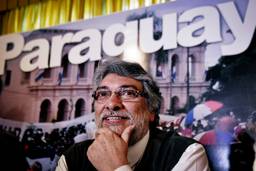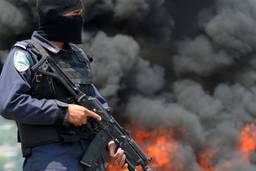Is the U.S. Enabling the Humanitarian Crisis in Colombia?
Millions remain displaced and war crimes are ongoing, but U.S. military aid keeps flowing.
Jeremy Kryt

It’s a cruelly hot day in rebel-held territory. On a crumbling and abandoned plantation, in the insurgency riddled Cauca region of southwestern Colombia, more than three dozen indigenous leaders have gathered in the shade of the old manor house for a tribal meeting. Children’s murals and peace-themed banners cover the white-washed adobe walls. Outside, in the mortar-cratered fields that once grew sugar cane for the California market, shirtless men labor in the noon heat to plant beans and squash.
“We’re in a hard place,” says Ernesto Conda, a ruling council member of the Nasa tribe, one of several indigenous groups native to Cauca. Conda is 44 and wears his hair in a sleek black queue streaked with gray.
“Our people are always under fire here — always in range of the mortars and machine guns,” he says, taking a break from the tribal council to show this reporter around the former plantation, which the Nasa have occupied in a bid to raise subsistence crops. The twenty or so families who now squat here were driven from their homes in Cauca’s jungle-covered mountains by fighting between leftist guerrillas, right-wing militias, and Colombian troops.
These Nasa families are among the 4.7 million internally displaced Colombians produced by five decades of civil war, according to a recent study by a government-sponsored truth commission called the National Center for Historic Memory. The report revealed that the number of internal refugees in this resource-rich Andean nation is the highest of any country on earth. The struggle between Bogota’s armed forces and right-wing proxy militias and the nation’s largest, leftist insurgency, the Revolutionary Armed Forces of Colombia (FARC), has claimed more than 220,000 lives, 82 percent of them civilians. Untold thousands of native Nasa have also been killed in the world’s longest-running civil war. In the Cauca region alone at least 128 native peoples have been slain in conflict-related violence since the start of 2012.
Peace talks aimed at ending the war with FARC have been dragging on in Havana, Cuba, since last fall. Little progress has been made so far, and the fighting continues apace. At least 48 government troops have been killed in the last two months, and at least 12 insurgents lost their lives to airstrikes in August. August also saw civilians erupt over the root causes of the armed conflict — vast poverty and stark inequality of land ownership. Massive protests aimed at land reform and curtailing economic globalization shook the country. Despite a crackdown on demonstrations by President Juan Manuel Santos, the ongoing protests continue to paralyze shipping and transportation, especially in war-torn rural regions like Cauca.
In spite of its poor track record on human rights, Colombia remains a close regional ally of Washington, and, under the umbrella of the Drug War, receives more military aid than any other nation in the hemisphere. But now, in the wake of the truth commission report and Bogota’s brutal response to the nationwide protests, a growing chorus of international observers contend that U.S. foreign policy — including military aid and trade agreements — could be helping to fuel the violence and contributing to the plights of those caught in the crossfire, like Conda’s displaced Nasa families.
“Free trade agreements, and globalization in general, have winners and losers,” says Adam Isacson, of the Washington Office on Latin America (WOLA), in an interview with In These Times. “When they protest what is being done to them, those on the losing end are often accused of sympathizing with guerrillas, and end up facing a response from Colombia’s security forces. The same forces that have been aided and strengthened by many years of U.S. assistance.”
‘A real humanitarian crisis’
Desperate living conditions among Colombia’s displaced and rural poor sent tens of thousands of small farmers and indigenous into the streets on August 19, in a series of mass protests that shook the nation. Demanding land reform and an end to U.S.-brokered free-trade agreements that undercut the local economy, the farmers were soon joined by teachers and union workers in setting up road blocks at 72 major arteries across the country. On the last weekend of the month, 30,000 demonstrators marched on Bogota itself. After initially declaring that the protests did not exist, the government declared martial law. So far, clashes between demonstrators and police have left six protestors dead, with scores more wounded as authorities have repeatedly opened fire on peaceful marches with tear gas and even live rounds.
“This is a real humanitarian crisis,” says Judith Maldonado, director of the Bogota-based law firm Luis Carlos Peroz, which specializes in human rights cases. “The farmers feel they have been abandoned by the government. They look around and they see that they have no education system, no medical centers, and no future. So they are manifesting themselves in peaceful demonstrations,” Maldonado says. “But the government can’t tolerate mass protests.”
To stem the protests, Colombian President Jose Santos ordered the mobilization of 50,000 troops to occupy Bogota and other urban zones. Nasa chief Conda says such an iron-fisted response by the government will do nothing to ease the widespread suffering and harsh living conditions that inspired the popular uprising.
“The fighting has been going on now since the middle of the last century,” says Conda, clutching the tasseled, silver-capped baton that is a symbol of his tribal authority. “It’s a perpetual social crisis for our communities — especially for our young people, because they don’t see a way out.”
Terror attacks on the rise
Six illegal armed groups operate in Nasa territory, according to the Council of the Association of Indigenous of Northern Cauca (ACIN). All six groups traffic in arms and narcotics, flagrantly violating traditional Nasa land rights. Although weakened by decades of war, the FARC can field about 9,000 fighters nationwide, and the Marxist insurgency still maintains the biggest armed presence in Cauca. But they’re being challenged by a number of smaller, largely right wing militias who claim to hate the FARC for ideological reasons, while also coveting the drug-production facilities and territory they control.
As the competition among narco-traffickers increases, violence against civilians has worsened, both in Cauca and the nation at large. Human Rights Watch lists a 34 percent jump in massacres committed by far-right paramilitary groups since 2010. Meanwhile, FARC blocs routinely conscript child soldiers from rural villages and deploy land mines and car bombs against civilian population centers that deny the guerrillas supplies or defy their authority. The annual U.S. Country Report on Terrorism shows that, overall, terror attacks are on the rise across Colombia. So far 2013 has also brought a sharp spike in attacks against human rights investigators; 17 human rights workers were killed just in Cauca last year.
But rebels and drug runners aren’t the only armed groups bullying the natives. Colombia’s indigenous and small farmers say they are also being targeted by rogue forces of the Colombian government. Illegal detentions and searches are commonplace, as are extrajudicial killings. The killings are so widespread there’s even a nickname for them — “false positives” — because of the soldiers’ habit of dressing up the victims in insurgent uniforms to raise their units’ body counts. There have been more than 3,000 such killings in the last decade.
U.S. military aid
Of the 2,000 general massacres committed in Colombia since 1980, more than two-thirds were by far-right militias with ties to the armed forces, or by the armed forces themselves, according to the new truth commission report. The military and police alone are responsible for 42 percent of the nation’s 25,000 disappearances. Despite heightened scrutiny by the State Department, and the Colombian government’s claim to have purged all rogue units, rights groups have documented some 50 war crimes committed by Colombian troops, including false positives and illegal detentions, in 2012.
Congress passed the Leahy Law in 1997, to prevent U.S. military aid from enabling just these kinds of abuses abroad, but a lack of oversight and political will have hampered reform efforts.
“Even units that have been vetted and cleared [by the U.S. State Department] to receive aid are committing false positives,” says WOLA’s Isacson.
Due to the lack of effective oversight and issues of U.S. culpability in regard to war crimes and civil abuses, John Lindsay-Poland, research director of the California-based Fellowship of Reconciliation (FOR), who recently returned from a fact-finding trip to Colombia, believes that:
“U.S. military aid to Colombia should be cut. It’s a contribution to war when there are peace talks to end the 49-year old armed conflict,” says Lindsay-Poland. “The [Colombian] military has murdered thousands of civilians with almost total impunity.”
“Military aid is not enough”
The wild and rugged Cauca region is one of those hit hardest by the violence due to its rough and tumble topography, a confluence of major roads, and a perfect climate for growing illicit crops (especially coca leaves, the raw ingredient for cocaine). The dark heart of Colombia’s drug-fueled conflict, Cauca is also home to one of the highest rates of false positive cases of any Colombian department, or state.
In northern Cauca, a gap in the mountains forces cocaine shipments from the country’s southern highlands into a narrow funnel, turning the road to Cali and the coast into a fiercely-contested battleground. Drug-running guerrillas and paramilitary bands compete with government troops and each other for of the access point, with the indigenous and small farmers often trapped in between when firefights erupt or chopper strikes are called in.
“First we try to take the high ground and the mountain tops,” says Colonel Germán Lopez, commander of Forward Operating Base Caloto, sitting at his desk in the sandbagged command bunker. “From there we can move out to provide security to small towns and villages and try to hold the roads… But it’s not easy. Sometimes the guerrillas are hidden in houses. Sometimes they’re wearing civilian clothes. When an ambush happens suddenly it’s very hard to know who’s doing the shooting, and who is just a bystander.”
Lopez, who received counter-insurgency training in Texas and keeps a large Bible mounted prominently on his desk at Caloto, tells this reporter that U.S. assistance was “absolutely essential” to maintaining security in Cauca.
“But military aid is not enough,” Lopez says. “The biggest cause of crime and [drug smuggling] in Cauca is the terrible poverty. We’ve got to build trust and confidence by helping the local population – by giving the people something to believe in.”
FOR director Lindsay-Poland agrees.
“[Military aid] doesn’t address … the driving force[s] of drug trafficking,” he says. “Civilian needs [in Colombia] for education, health care, housing, infrastructure, and environmental protection are underfunded in a thousand ways.”
Since 2009 Washington has sent more than 2.03 billion dollars in military and police aid to Colombia—25 percent more than was spent to fight the Drug War in Mexico during the same span. About $280 million more are in line to be sent in 2013.
The funding of Colombia’s armed forces continues despite the evidence offered in a 2010 study which showed that the rate of extrajudicial killings and other war crimes committed by individual units often spiked just after receiving U.S. aid in the form of training, construction, helicopter fleets, and advanced weapon systems. The rate of recorded atrocities by those same units subsequently went down when aid was withdrawn.
“So many units have committed terrible rights abuses after they’ve received [military] assistance,” says Lindsay-Poland, who has served as an advisor to the State Department on Colombia. He accuses the Obama administration of failing to “evaluate the human rights impact of enormous of amounts of military assistance” in Colombia.
“A policy based on ending violence … would look a lot different’
In support of its continued aid to the Colombian government, U.S. officials can point to the numbers: according to information In These Times received from the U.S. State Department’s Bureau of International Narcotics and Law Enforcement Affairs, coca leaf cultivation in Colombia went down seven percent from 2011 – 2012, largely due to aerial spraying and ground-based eradication efforts by the army. Overall production of pure Colombian cocaine has fallen from an all-time high of 700 metric tons in 2001 to just 175 metric tons in 2012 — a drop of 75 percent. Due to such optimistic numbers, some in Washington have begun to trumpet Drug War efforts in Colombia as a model to be followed in Mexico and Central America.
But even as cocaine production has fallen, Colombia’s insurgents and criminal bands have turned to other sources of funding, such as mining for precious metals, which make them less dependent on narco-trafficking. And the dip in drug production has not led to a decrease in violence. Like many other critics, FOR director Lindsay-Poland refuses to label the Colombia model a success:
“Any program that has resulted in, or done nothing to stop, the forced displacement of five million people is not a success, but a human rights disaster,” he says. “A policy based on ending violence instead of reducing coca leaves would look a lot different.”
The State Department declined In These Times’ request to comment on human rights abuses in Colombia.
The right to exist
Not only do some critics contend that U.S. military aid is enabling human rights abuses, but they also allege U.S.-authored free-trade agreements are crippling the Colombian economy.
“Those who lose include farmers who can’t compete with cheaper inputs, workers unable to bargain collectively, and indigenous and afro-Colombian communities sitting atop fertile land, valuable minerals, or oil,” says WOLA’s Isacson.
Those claims are echoed by the striking farmers, who continue to block roads and hold rallies in multiple departments. They say that the high-priced imported seeds and low-cost grains that Colombia is obligated to purchase as part of the U.S.-Colombia Free Trade Agreement make it impossible for local producers to compete.
“The trade agreements benefit the wealthy landowners, who in turn support the politicians in Bogota,” says law firm director Maldonado, who represents a farmers union. “There is nothing democratic about it.”
Back in Cauca, Nasa chief Conda says it’s hard for him to understand why basic living conditions remain so harsh for the country’s 15 million small farmers, indigenous and Afro-Colombians who live in poverty, given the billions of U.S. dollars that have been handed over to Bogota in recent years.
“The government has no presence here,” says Conda. “We have no sustainable economy of any kind. Already our houses have been destroyed. Our people without liberty. Our children mutilated by land mines,” Conda gazes out over the weed-grown fields and shattered outbuildings of the ruined plantation where his people have come for shelter.
“We have the right to exist,” Conda says. “We have the right to live.”








